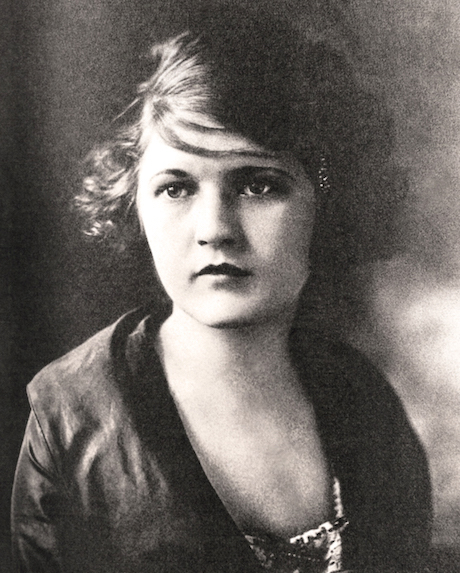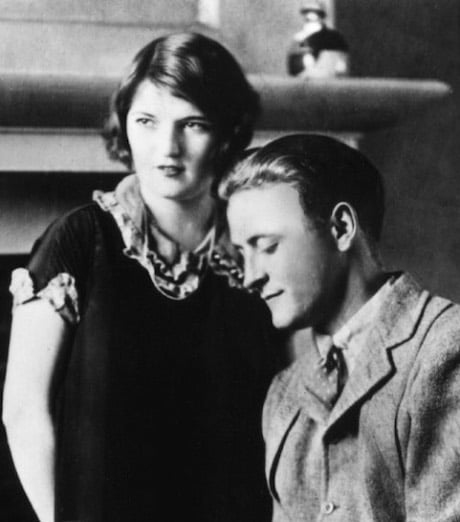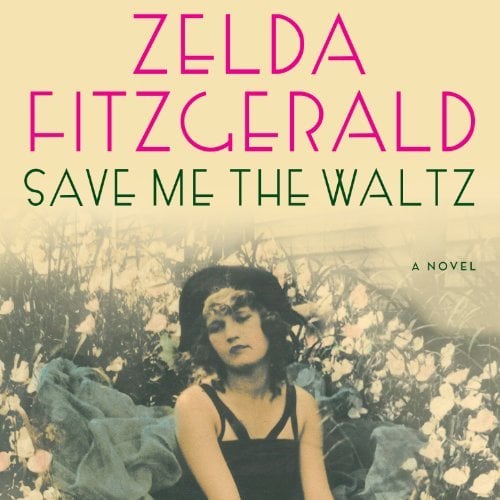Myself vs. Myself: Save Me the Waltz and Other Writings of Zelda Fitzgerald
By Elodie Barnes | On May 30, 2022 | Updated July 8, 2025 | Comments (2)

Zelda Sayre Fitzgerald (1900 – 1948) is best known as the wife of writer F. Scott Fitzgerald and for being the first true Jazz Age flapper in the 1920s. She was also a talented painter and dancer, as well as a writer in her own right. Here, we’ll explore Save Me the Waltz and other writings of Zelda Fitzgerald, which certainly deserve a fresh look.
Struggling first against the excesses of her own Roaring Twenties lifestyle and then battling mental illness, Zelda never achieved the critical success of her husband nor had the chance to fully develop her skills. According to her daughter Frances (Scottie) Fitzgerald:
“It was my mother’s misfortune to have been born with the ability to write, to dance, and to paint, and then never to have acquired the discipline to make her talent work for, rather than against, her.”
It has only been relatively recently that her creative achievements, and her writing, in particular, are starting to be revisited and re-examined.
The search for a creative outlet
Throughout the 1920s, Zelda and Scott were one of the most famous Jazz Age couples of the era. They had lived the high life in New York and had then shifted across the Atlantic, following the tide of so many other Americans seeking the relative artistic and sensual freedom that France offered.
Soon they were riding the rollercoaster of parties, alcohol, infidelity, and excess in Paris and on the Riviera. Scott was enjoying his success, busy writing the short stories that paid some of the bills and working on the next novel, but Zelda was becoming increasingly frustrated at her own lack of a creative outlet.
As a child and teenager, Zelda had been an accomplished dancer. She had also written a few short “guest celebrity” pieces early in her marriage, including a review of Scott’s novel The Beautiful and the Damned, but as a woman and wife of a famous author, she was not expected to have the talent of her own. However, Zelda found that she had no desire to be simply a wife and mother and muse to her husband.
In 1927, at the age of twenty-seven, Zelda started taking ballet lessons again. She studied with notable teachers including Lubov Egorova in Paris, and it soon became an obsession that preoccupied her for up to eight hours a day, often to the detriment of her relationships with her husband and daughter.
She installed a large mirror and a barre at home where, in addition to the time spent at the studio, she would practice for hours.
These lessons were reluctantly paid for by Scott, an arrangement which Zelda also disliked intensely. To support herself and to be able to pay for her own lessons, she began to write again. Articles and short stories including Our Movie Queen, Miss Ella, and A Couple of Nuts were published in Harper’s Weekly, The Smart Set, and The Saturday Evening Post.
Most of the stories appeared under her husband’s name. The F. Scott Fitzgerald byline fetched a far higher price and made it easier to get pieces accepted, but it also meant that Zelda struggled to establish any kind of writing the identity of her own.
Zelda also faced challenges in the ballet studio. In her mid-twenties, she was too old to achieve her dream of becoming a prima ballerina, but she could still have made a career out of it had her health not failed.
In the autumn of 1929, she was offered a salaried position with the San Carlo Opera Ballet Company in Naples, dancing a solo role initially in Aida with more solos to follow during the season, but had to decline the offer as she was not mentally capable of fulfilling the demanding contract.
. . . . . . . . .

More about Zelda Fitzgerald
. . . . . . . . .
Declining health and mental illness
Within months, she was hospitalized with hallucinations, anxiety, depression, suicidal thoughts, and exhaustion. She discharged herself against her doctor’s advice, desperate to return to the ballet studio, but within weeks she had relapsed.
This time she was sent to a hospital in Switzerland, where the doctors recommended psychological treatment. After seeing a highly sought-after psychiatrist, Dr. Oscar Forel, she was diagnosed with schizophrenia.
She arrived at the clinic in Switzerland in June 1930 and stayed for over a year. The rest of her life would be spent in and out of hospitals and sanatoriums in both Europe and the U.S.
Save Me the Waltz and tensions with Scott
In early 1932, she was a patient at the Phipps Clinic outside Baltimore in Maryland. It was here that she wrote the first draft of her only novel, Save Me The Waltz, in just two months. It tells the story of Alabama Beggs and her painter husband David, whose artistic success and flamboyant lifestyle lift them from their Southern roots into a whirlwind of New York celebrity. It’s a clear roman à clef based on her own life and, to a lesser extent, that of her husband.
It was far from her first foray into writing fiction, but it was the first time she had ever written anything and sent it to a publisher without showing it to her husband beforehand.
She chose Max Perkins, her husband’s own editor, writing to him, “Scott completely being absorbed in his own [novel] has not seen it, so I am completely in the dark as to its possible merits but naturally terribly anxious that you should like it.”
Zelda wanted desperately to be taken seriously as a writer, and for the first time wanted her work to be evaluated on its own merits, without her husband’s intervention, opinion, or the use of his name.
When Scott did see the novel soon after, he was furious. He wrote to Zelda’s doctor accusing her of plagiarizing several ideas from his current novel-in-progress, which would become Tender Is the Night — “literally one whole section of her novel is an imitation of it, of its rhythm, materials…” — and of exposing too much of his private life.
He was also angry that she had named one of her main characters Amory Blaine, a name that her husband had also used in This Side of Paradise. Scott fumed, “This mixture of fact and fiction is calculated to ruin us both … my God, my books made her a legend and her single intention in this somewhat thin portrait is to make me a nonentity.”
Zelda wrote to Scott to try and explain why she had not sent him the manuscript first:
“Purposely I didn’t — knowing that you were working on your own and honestly feeling that I had no right to interrupt you to ask for a serious opinion. Also, I know that Max will not want it and I prefer to do the corrections after having his opinion …
I was also afraid we might have touched on the same material. Also, feeling it to be a dubious production due to my own instability I did not want a scathing criticism such as you to have mercilessly — if for my own good given my last stories, poor things. I have had enough discouragement, generally, and could scream with that sense of inertia that hovers over my life and everything I do.”
. . . . . . . . . .

. . . . . . . . . .
Fantasy versus reality
It wasn’t the first time that the lines between fact and fiction had become blurred. Scott, too, often conflated fantasy and reality in his novels: he once said to Malcolm Crowley, “Sometimes I don’t know whether Zelda isn’t a character that I created myself.”
In her 1922 review of her husband’s novel The Beautiful and Damned, Zelda had written:
“It seems to me that on one page I recognized a portion of an old diary of mine which mysteriously disappeared shortly after my marriage, and also scraps of letters which, though considerably edited sound to me vaguely familiar. In fact, Mr. Fitzgerald — I believe that is how he spells his name — seems to believe that plagiarism begins at home.”
Indeed, Scott used lines from Zelda’s letters and diaries throughout his writing career, most notably in This Side of Paradise, The Beautiful and Damned, The Great Gatsby, and Tender Is the Night.
Scott, on the other hand, didn’t appreciate Zelda doing the same thing. While his side of the correspondence has been lost, he must have sent Zelda a curt reply to her explanatory letter, because, in her next letter to him, Zelda wrote:
“I glad[ly] submit to anything you want about the book or anything else…However, I would like you to thoroughly understand that my revision will be made on an aesthetic basis: that the other material which I will select is nevertheless legitimate stuff that has cost me a pretty emotional penny to amass and which I intend to use when I can get the tranquility of spirit necessary to write the story of myself versus myself.”
Zelda’s writing style
Over the next few months, Zelda revised the novel, this time with some input from Scott — although how much he influenced the revisions is unclear, as the original drafts have been lost. His own opinion of the novel varied dramatically, sometimes feeling that it was “perhaps a very good novel” and other times claiming that it was “a bad book.”
In part, then, it’s Zelda’s story the way that her husband wanted it to be told, but there are still elements that are very different from Scott’s and that can therefore be assumed are Zelda’s unique style — lush description, vivid colors, a southern summer brought to life in dripping heat and suffocating magnolias, the anguish and pain of obsession and alcoholism, and the frantic search for an identity outside of marriage.
The rich prose style has also been connected to Surrealism, in its attempts to disrupt realism by creating unexpected connections. In the novel, Alabama’s first kiss with David becomes a deep, nightmarish dive into the frontal cortex of his brain:
“She crawled into the friendly cave of his ear. The area inside was grey and ghostly classic as she stared about the deep trenches of the cerebellum. There was not a growth nor a flowery substance to break those smooth convolutions, just the puffy rise of sleek grey matter…”
Edmund Wilson likened it to the way Zelda spoke:
“She talked with so spontaneous a color and wit — almost exactly in the way that she wrote — that I very soon ceased to be troubled by the fact that the conversation was in the nature of the free association of ideas and one could never follow up anything. I have rarely known a woman who expressed herself so delightfully and freshly; she had no ready-made phrases on the one hand and made no straining for effect on the other.”
. . . . . . . . . .

. . . . . . . . . .
Publication of Save Me the Waltz and subsequent writings
Save Me the Waltz was finally published in 1932 in a print run of likely no more than 3,000 copies. Only around 1,200 sold, and the novel went out of print after this first run.
Its publication did not ease any of the tensions between the Fitzgeralds. Zelda wanted to continue to write, while Scott told her she was “a third-rate writer and a third-rate ballet dancer … I am a professional writer, with a huge following. I am the highest-paid short story writer in the world.”
Zelda did start another novel, Caesar’s Things, and worked on it intermittently for the rest of her life. It never came to anything. She also turned to scriptwriting and attempted to produce a play called Scandalabra, described as a fantasy farce in a prologue and three acts.
Having been forbidden by Scott to use any autobiographical material that might coincide with what he wanted to use for Tender Is the Night, Zelda struggled even for a storyline. It was performed by a small Baltimore theatre company in 1933, but its rambling banter only confused the critics. Still mentally unstable, in and out of psychiatric clinics, and at odds with her husband much of the time, Zelda then turned to paint instead.
Zelda’s Legacy
Save Me the Waltz was republished by Southern Illinois Press in 1967 (it required some 550 spelling and grammar corrections), and then again by the University of Alabama in 1991 in The Collected Writings of Zelda Fitzgerald.
More recently, it has been reissued by Handheld Press. However, interest in Zelda’s writing and life has only really surged since the 2013 film adaptation of The Great Gatsby. Several novels have been based on her life.
One of them, Z: A Novel of Zelda Fitzgerald by Therese Anne Fowler, has also been made into an Amazon Prime original series called The Beginning of Everything.
There have also been more scholarly explorations of Zelda’s work, including The Subversive Art of Zelda Fitzgerald by Deborah Pike, which takes Zelda out of her husband’s shadow and places her work alongside other female writers and painters of the time such as Leonora Carrington.
Rightly or wrongly, there has been a tendency to give her the label of feminist, and there has been endless debate over the reasons for her lack of creative success. Many like to blame her husband, while an argument has also been put forward that she was constrained from the start by the era in which she was born.
The idea of Zelda as a woman trapped by circumstance has been dismissed by her daughter, who argued that viewing Zelda as a “classic ‘put-down’ wife whose efforts to express her artistic nature were thwarted by a typically male chauvinist husband…is not, in my opinion, accurate.”
However she is defined, perhaps her greatest achievement was summed up by Therese Anne Fowler, who wrote:
“Here we have a woman whose talents and energy and intellect should have made her a brilliant success, who was determined to be an accomplished artist, writer, and ballet dancer in an era where married women were supposed to be wives and mothers, period.”
. . . . . . . . .
Contributed by Elodie Barnes. Elodie is a writer and editor with a serious case of wanderlust. Her short fiction has been widely published online, and is included in the Best Small Fictions 2022 Anthology published by Sonder Press. She is Books & Creative Writing Editor at Lucy Writers Platform, she is also co-facilitating What the Water Gave Us, an Arts Council England-funded anthology of emerging women writers from migrant backgrounds. She is currently working on a collection of short stories, and when not writing can usually be found planning the next trip abroad, or daydreaming her way back to 1920s Paris. Find her online at Elodie Rose Barnes.
Further reading:
- Save Me the Waltz by Zelda Fitzgerald, Handheld Press, 2018
- The Collected Writings of Zelda Fitzgerald, ed. Matthew J. Bruccoli,
University of Alabama Press, 1997 (3rd ed) - Zelda Fitzgerald: Her Voice in Paradise by Sally Cline, John Murray, 2003
- Dear Scott, Dearest Zelda: The Love Letters of F. Scott and Zelda Fitzgerald,
ed. by Jackson R. Bryer and Cathy W. Barks, Bloomsbury, 2003 - Z: A Novel of Zelda Fitzgerald by Therese Anne Fowler, Two Roads Press, 2013
Thank you for this summary of Zelda Fitzgeralds life. I have also read each of the “further readings”. A good start.
Belated thanks for your comment, William, and I’m glad you found this post useful!